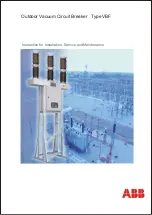
2. Con l'interruttore in posizione OFF:
-- Controllare l'assenza di usura o danni dei
contatti d'arco fissi.
-- In caso, sostituirli con nuovi contatti d'arco
fissi e stringere le viti di fissaggio a 16Nm.
-- Controllare la coppia di serraggio dei
parascintille mobile e fisso (Fig 5.2) applicando
una coppia di serraggio di 12Nm.
...-- In caso fossero presenti viti allentate, serrare
con una coppia di 16Nm.
3.
Rimontare la camera d'arco, serrare con una
coppia di 12 Nm.
Controllo meccanismo principale interruttore
-- Controllare l'azione di ON e OFF
dell'interruttore manualmente e - se il caso - in
remoto.
-- Controllare l'azione di intervento mediante la
bobina di minima tensione, se installata.
-- Controllare il corretto funzionamento di tutti
gli indicatori.
-- Se il contatore di manovre è installato,
controllare che il numero di manovre sia
adeguato alle specifiche dell'interruttore.
5.3 Controllo della parte fissa
-- Controllare che la base della parte fissa sia
priva di detriti.
-- Utilizzando l'opportuno attrezzo installato
nella parte fissa (vedere sezione 4) aprire e
controllare l'assenza di danni o di usura
eccessiva dei contatti principali.
-- Se installato: Verificare che i contatti di
posizione della parte mobile funzionino
correttamente inserendo ed estraendo
l'interruttore dalla posizione CONNECTED.
5.4 Controllo usura contatto
-- Se installati: Controllare gli indicatori d'usura
del contatto (vedere sezione 4)
5.5 Controllo contatti di
sezionamento (esecuzione estraibile)
1. Rimuovere l'interruttore dalla parte fissa e
posizionarlo su una superficie di lavoro idonea.
2. Controllare la presenza di segni di usura o
sovrariscaldamento sul blocco a contatti
striscianti posteriore.
3. Rimuovere il blocco a contatti striscianti con le
apposite pinze speciali.
4. Pulire i contatti di sezionamento con un panno
morbido e pulito per eliminare qualsiasi traccia
di sporco o grasso.
5. Applicare un sottile strato di grasso di
paraffina (gradazione 8802).
2. Leistungsschalter in der AUS-Stellung
bringen:
-- Prüfen Sie, ob Anzeichen von Abnutzung oder
Beschädigung an den festen Lichtbogen-
kontakten erkennbar sind.
-- Falls Sie die festen Lichtbogenkontakte
auswechseln, ziehen Sie die Befestigungs-
schrauben bitte mit 16 Nm fest.
-- Prüfen Sie das Drehmoment der beweglichen
und festen Lichtbogenleitbleche (Fig. 5.2) durch
die Anwendung eines Drehmomentes von 12
Nm.
-- Wenn eine gelockerte Schraube gefunden
wurde, bitte wieder mit 16 Nm festziehen.
3.
Setzen Sie die Lichtbogenkammer wieder auf,
Anziehdrehmoment 12 Nm.
Leistungsschaltermechanik-Hauptinspektion
-- Überprüfen Sie die Leistungsschalter EIN- und
AUS-Funktionen sowohl manuell als auch per
Fernauslösung, wenn zutreffend.
-- Überprüfen Sie Auslösungsvorgänge durch
den Unterspannungsauslöser, falls installiert.
-- Prüfen Sie alle Meldeeinheiten und deren
korrekte Funktion.
-- Prüfen Sie die Zahl der durchgeführten
Schaltungen, wenn ein Schaltzahlzähler
installiert ist, entsprechend der
Leistungsschalter-Spezifikationen.
5.3 Einschubträger-Inspektion
-- Stellen Sie sicher, dass der Unterboden des
Einschubträgers frei von Schmutzteilen ist.
-- Überprüfen Sie die am Einschubträger
installierten Kontakte auf übermäßige
Abnutzung oder Beschädigung.
-- Falls installiert, überprüfen Sie die
Einschubträger-Positionsmeldeschalter
Funktionen, während Sie den Leistungsschalter
in die und aus der BETRIEBS-Stellung verfahren.
5.4 Kontaktverschleiß-Inspektion
-- Wenn vorhanden, überprüfen Sie den Abbrand
mit der Kontaktverschleißanzeige (siehe Kapitel
4).
5.5 Trennkontakte (Ausfahrtechnik)
Inspektion
1. Entfernen Sie den Leistungsschalter aus dem
Einschubträger und placieren Sie ihn auf eine
geeigneten Arbeitsoberfläche.
2. Überprüfen Sie die hinteren Einfahrkontakte
auf Anzeichen einer Überhitzung und Verschleiß.
3. Entfernen Sie die Einfahrkontakte mit einer
besonderen Einfahrkontakt-Zange.
4. Reinigen Sie die Kontakte und Anschlüsse mit
einem weichen, sauberen Tuch und entfernen
Sie alle alten Fett oder Schmutzreste.
5. Tragen Sie einen dünnen Film weißes
Paraffinfett (Klasse 8802) auf.
2.
With Circuit Breaker set in it's OFF position:
-- Check if there is any evidence of fixed arcing
contact wear or damage:
-- If there is replace with new fixed arcing
contacts and tighten the fixation screws to
16Nm.
-- Check the torque of the moving and fixed arc
runner screws (Fig 5.2) by applying a tightening
torque of 12Nm.
...-- If any screw is found to be loose re-tighten
the screw with a 16Nm torque.
3
. Re-assemble the arc chamber, tightening
torque 12 Nm.
Circuit Breaker Main Mechanism Inspection
-- Check the circuit breaker ON and OFF action
both manually and by remote means, if
appropriate.
-- Check tripping action by means of the
Undervoltage Release, if installed.
-- Check all indicators for correct function.
-- Check number of operations, if Operations
Counter is installed, to the circuit breaker's
specification.
5.3 Cassette Inspection
-- Ensure the base of the cassette is clear of
debris.
– Inspect the Cassette's main contact for
excessive wear or damage.
-- If installed: Verify if the carriage switches
operate correctly by racking the breaker IN &
OUT of the CONNECTED position.
5.4 Contact wear Inspection
-- If installed: Check contact wear indicators (see
section 4)
5.5 Isolating Contacts (Drawout Type)
Inspection
1. Remove the circuit breaker from the cassette
housing and place it on a suitable working
surface.
2. Inspect the rear cluster contacts for signs of
overheating and wear.
3. Remove the cluster contacts using the special
cluster pliers.
4. Clean the isolating contacts and terminals
with a soft, clean cloth to remove any old grease
or dirt.
5. Apply a thin film of white paraffin grease
(grade 8802).
Maintenance
Tr
ouble
LOCKS
BREAKER ME10
INTRO
BREAKER
ACCESSORIES
TESTS
APPENDIX
TRIP UNIT
5-02






































